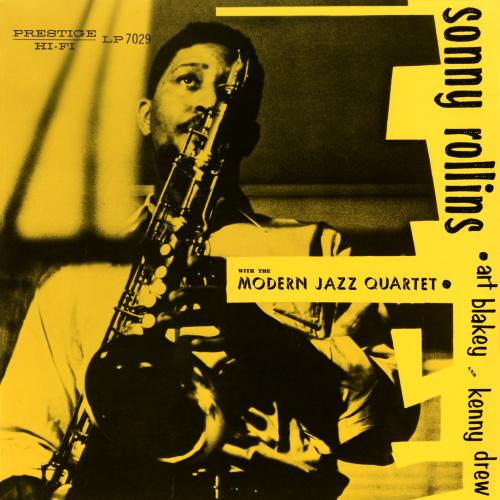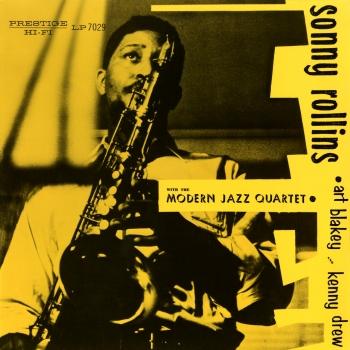
Sonny Rollins With The Modern Jazz Quartet (Remastered) Sonny Rollins with The Modern Jazz Quartet
Album Info
Album Veröffentlichung:
1956
HRA-Veröffentlichung:
20.01.2017
Label: Concord Records
Genre: Jazz
Subgenre: Cool
Interpret: Sonny Rollins with The Modern Jazz Quartet
Das Album enthält Albumcover Booklet (PDF)
Entschuldigen Sie bitte!
Sehr geehrter HIGHRESAUDIO Besucher,
leider kann das Album zurzeit aufgrund von Länder- und Lizenzbeschränkungen nicht gekauft werden oder uns liegt der offizielle Veröffentlichungstermin für Ihr Land noch nicht vor. Wir aktualisieren unsere Veröffentlichungstermine ein- bis zweimal die Woche. Bitte schauen Sie ab und zu mal wieder rein.
Wir empfehlen Ihnen das Album auf Ihre Merkliste zu setzen.
Wir bedanken uns für Ihr Verständnis und Ihre Geduld.
Ihr, HIGHRESAUDIO
- 1 The Stopper 03:00
- 2 Almost Like Being In Love 03:26
- 3 No Moe 03:32
- 4 In A Sentimental Mood 03:21
- 5 Scoops 02:17
- 6 With A Song In My Heart 03:11
- 7 Newk's Fadeaway 03:16
- 8 Time On My Hands 02:43
- 9 This Love Of Mine 02:27
- 10 Shadrack 02:35
- 11 On A Slow Boat To China 02:42
- 12 Mambo Bounce 02:25
- 13 I Know 02:31
Info zu Sonny Rollins With The Modern Jazz Quartet (Remastered)
Always gifted with a big band sound and a pure sense of swing, Sonny Rollins did not emerge full-blown from the foam like Venus. He gained polish and experience with Bud Powell, J.J. Johnson, Miles Davis and Thelonious Monk, before making his Prestige debut as a leader at the tender age of 21. With The Modern Jazz Quartet celebrates the tenor saxophonist's first three 10-inch LPs—Mambo Jazz, Sonny Rollins Quartet, and Sonny Rollins with Milt Jackson--and is culled from sessions in December of 1951 and October of 1953.
There is much joy and rhythmic elation in Rollins' early vamp figures such as "Shadrack" and "Scoops," where he preaches with a stomping fervor that anticipates the hard bop movement. On "Newk's Fadeaway," he hints at the harmonic freedom and plasticity of line that would distinguish his early triumphs, while "Mambo Bounce" (sampled early and often by the acid jazz crowd) is a delightful early mixture of Afro-Cuban and swing textures, prefiguring his later uses of calypso melodies and rhythms.
And while Rollins' ballad playing doesn't approach the harmonic depths he would routinely invoke in later years, his smoky tone and behind-the-beat phrasing suggest an affinity for middle period Lester Young ("This Love Of Mine" and "With A Song In My Heart"), even as his thicker timbre and robust articulation point to Coleman Hawkins and Ben Webster ("With Time On My Hands"). By the time he takes on Ellington's "In A Sentimental Mood" with the Modern Jazz Quartet, his tone has really filled out and he's improvising with a broader range of inflections. "The Stopper" offers a garish chase with cute starts and stops, while "No Moe" is a classic line that inspires vigorous, easy-going blues interplay. And for hard swinging, "It's Almost Like Being In Love" hints at future virtuoso turns on the popular song.
„Included here are some of Sonny Rollins' earliest sessions as a bandleader. These are among the fresh and vibrant baker's dozen of selections on Sonny Rollins With the Modern Jazz Quartet (1953). The title is a bit misleading though, since the MJQ -- with John Lewis (piano), Milt Jackson (vibes), Percy Heath (bass), and Kenny Clarke (drums) -- is only accounted for during the first four sides. There is a playful and energetic tone that ricochets from Jackson's fluid vibes, landing firmly in Rollins' musical court. One prime example of this interaction is heard throughout the solos on the opening track, "Stopper." Similarly, "Almost Like Falling in Love" bops, weaves, and swings throughout, with some expressive contributions via Lewis, effectively linking Rollins' and Jackson's solos. "No Moe," which stands as one of the best originals on the disc, also bears their undeniable connection. Another not-to-be-missed reading is the sultry "In a Sentimental Mood." Here, Rollins spirals mature and ethereal lines against Jackson's resonant intonation and shimmer. If just for these tunes, Sonny Rollins With the Modern Jazz Quartet is a vital component in any jazz enthusiasts' collection. The rest of the disc is performed by Rollins and a quartet that also includes the talents of Kenny Drew (piano), the MJQ's Percy Heath (bass), and the main Jazz Messenger, Art Blakey (drums). On the original tune "Scoops," Blakey's hardball antics provide well-placed sonic interjections, punctuating Rollins' highly infectious melodic sense. While on the subject of catchy tunes, all ears should be directed to the biblically derived title "Shadrack," which had been a signature piece for Louis Armstrong. This early incarnation of the Sonny Rollins Quartet has rarely sounded as cohesive, as they collectively percolate with their definitive execution. Of particular note is the inclusion of Miles Davis' "I Know." This extension of Charlie Parker's "Confirmation" features Davis on piano accompanying Rollins with solid chord progressions, allowing the burgeoning player to lead his first-ever quartet with Heath and Roy Haynes (drums).“ (Lindsay Planer, AMG)
Tracks 1-4: October 7, 1953
Sonny Rollins, tenor saxophone
John Lewis, piano
Milt Jackson, vibes
Percy Heath, bass
Kenny Clarke, drums
Tracks 5-12: December 17, 1951
Sonny Rollins, tenor saxophone
Kenny Drew, piano
Percy Heath, bass
Art Blakey, drums
Track 13: Recorded January 17, 1951
Sonny Rollins, tenor saxophone
Miles Davis, piano
Percy Heath, bass
Roy Haynes, drums
Recorded at Apex Studios, New York City
Produced by Bob Weinstock
Digitally remastered
Please Note: We offer this album in its native sampling rate of 44.1 kHz, 24-bit. The provided 192 kHz version was up-sampled and offers no audible value!
Sonny Rollins
will go down in history as not only the single most enduring tenor saxophonist of the bebop and hard bop era, but also the greatest contemporary jazz saxophonist of them all. His fluid and harmonically innovative ideas, effortless manner, and easily identifiable and accessible sound have influenced generations of performers, but have also fueled the notion that mainstream jazz music can be widely enjoyed, recognized, and proliferated. Born Theodore Walter Rollins in New York City on September 7, 1930, he had an older brother who played violin. At age nine he took up piano lessons but discontinued them, took up the alto saxophone in high school, and switched to tenor after high school, doing local engagements. In 1948 he recorded with vocalist Babs Gonzales, then Bud Powell and Fats Navarro, and his first composition, "Audubon," was recorded by J.J. Johnson. Soon thereafter, Rollins made the rounds quickly with groups led by Art Blakey, Tadd Dameron, Chicago drummer Ike Day, and Miles Davis in 1951, followed by his own recordings with Kenny Drew, Kenny Dorham, and Thelonious Monk.
In 1956 Rollins made his biggest move, joining the famous ensemble of Max Roach and Clifford Brown, then formed his own legendary pianoless trio with bassist Wilbur Ware or Donald Bailey and drummer Elvin Jones or Pete La Roca in 1957, doing recorded sessions at the Village Vanguard. Awards came from Down Beat and Playboy magazines, and recordings were done mainly for the Prestige and Riverside labels, but also for Verve, Blue Note, Columbia, and Contemporary Records, all coinciding with the steadily rising star of Rollins. Pivotal albums such as Tenor Madness (with John Coltrane), Saxophone Colossus (with longstanding partner Tommy Flanagan), and Way Out West (with Ray Brown and Shelly Manne), and collaborations with the Modern Jazz Quartet, Clark Terry, and Sonny Clark firmly established Rollins as a bona fide superstar. He also acquired the nickname "Newk" for his facial resemblance to Brooklyn/Los Angeles Dodgers pitcher Don Newcombe.
But between 1959 and 1961 he sought a less superficial, more spiritual path to the rat race society of the times, visiting Japan and India, studying yoga and Zen. He left the music business until 1962, when he returned with the groundbreaking and in many ways revolutionary recording The Bridge with guitarist Jim Hall for the RCA Victor/Bluebird label. Rollins struck up a working relationship with trumpeter Don Cherry; did a handful of innovative LPs for the RCA Victor, MGM/Metro Jazz, and Impulse! labels; did one record with his hero Coleman Hawkins; and left the scene again in 1968. By 1971 he came back with a renewed sense of vigor and pride, and put out a string of successful records for the Milestone label that bridged the gap between the contemporary and fusion jazz of the time, the most memorable being his live date from the 1974 Montreux Jazz Festival, The Cutting Edge. Merging jazz with calypso, light funk, and post-bop, the career of Rollins not only was revived, but thrived from then onward. He was a member of the touring Milestone Jazz Stars in 1978 with McCoy Tyner and Ron Carter, and gained momentum as a touring headliner and festival showstopper.
His finest Milestone recordings of the second half of his career include Easy Living, Don't Stop the Carnival, G-Man, Old Flames, Plus Three, Global Warming, This Is What I Do, and Without a Song: The 9/11 Concert. He has worked extensively with road and recording bands that have included such artists as electric bass guitarist Bob Cranshaw; trombonist Clifton Anderson; pianists Tommy Flanagan and Stephen Scott; keyboardist Mark Soskin; guitarists Bobby Broom and Jerome Harris; percussionist Kimati Dinizulu; and drummers Jack DeJohnette, Perry Wilson, Steve Jordan, and Al Foster. Rollins formed his own record label, Doxy, through which he issued the CD Sonny, Please in 2006. Well into his eighth decade of life, Rollins continued to perform worldwide. As a composer, he will always be known for three memorable melodies that have become standards and well-recognized tunes in the jazz canon -- "Oleo," "Airegin," and especially "St. Thomas." (Michael G. Nastos). Source: Blue Note Records.
Booklet für Sonny Rollins With The Modern Jazz Quartet (Remastered)










